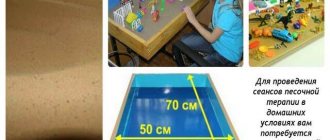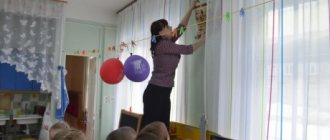According to Maria Montessori's periodization of development, the peak of activity in a variety of directions occurs in children precisely at the age of 2 to 3 years. Kids actively master speech and movement, learn to interact with a variety of objects, learn patterns and become sensitive to order, and also begin to expand their circle of acquaintances and make their first friends.
All this means that it is at this age that it is important to arrange for children all kinds of activities and games for harmonious development.
The motto of the Montessori philosophy is: “Help me do it myself.” The task of adults is to inspire children to make independent discoveries and achievements, because our little ones can do much more than it seems at first glance.
When planning Montessori activities for children 2-3 years old, you should adhere to the following rules:
- Classes should be aimed at increasing the child’s independence,
- Use different senses
- Include elements useful for the development of fine and gross motor skills,
- Take into account the interests of the child and use only at his request,
All Montessori activities should be presented to the child in advance, located in a place accessible to him (on a low shelf) and be accessible without the help of adults (however, exercises with small objects should be offered only when you have time to monitor the baby).
Montessori classes to develop a sense of order for children 2-3 years old
Such exercises help the child understand the principles by which our world exists; mainly here we work on sorting and classification.
Find a pair - Montessori classes for 2-3 years old
The principle of pair selection can be very widely used in working with children:
- Invite your child to sort his own socks and gloves.
- Print out images of animals and offer to compare the picture with existing toy models (the same can be done with your favorite cars, flowers, building models, etc.)
- Offer to find paired cards (colors, images, textures),
- Use special Montessori materials for 2 years and older
Sorting – complicated Montessori games for children from 2 years old
When the baby has mastered pairs, you can move on to a more complex option - sorting.
- Sort cards of different shades by color (you can cut pictures from magazines, scraps, colored cardboard, or you can buy a ready-made Montessori set),
- Remember Cinderella and offer to sort out different types of cereals. First, it is better to take larger grains: beans, chickpeas. Children's breakfast cereals with their cereals, pillows and rings can also be convenient,
- Sort out the box with grandma's buttons by shape, color or number of holes (you definitely have one!)
- Ask your child to put the cutlery in its place,
- Offer to clean up the kitchen and put all the cylinders and balls in one direction, and the cubes and parallelepipeds in the other,
- Rewind the salad: cucumbers to cucumbers, tomatoes to tomatoes, and so on
Establishing Montessori Sequences for a Child 3 Years and Under
- Lay out cards with simple stories and ask your child to remember the correct sequence of events.
- Use Montessori cylinders to help your child master the concepts of less-more and lower-higher,
- Learn simple self-care steps, breaking them down into steps. This way you can learn how to brush your teeth, take a shower, care for animals, and get ready for kindergarten.
How can a teacher prepare for the arrival of children in kindergarten?
One teacher rushes to work, plans the first lesson on the go and greets the kids in an excited state. And the other one came to the kindergarten in advance, calmly prepared the room for class and set himself up for a productive day. Which teacher is more likely to win over children and parents?
Some tips on how to start your working day:
- Come to work early, 15-20 minutes before your first child arrives. You will need this time to prepare for class.
- Ventilate the room. Think about what games you will need for the first lesson and arrange them in a child-friendly way. For example, you can prepare sports equipment for morning exercises and select upbeat music.
- Think about questions you want to ask parents when you meet. For example, how the child feels, how he responds to the kindergarten at home, whether the child learned a song for the event.
If the teacher has prepared for the meeting with the children, he will come out to them in a calm and relaxed state. Parents will feel that their children remain in good hands.
Montessori classes for the development of fine motor skills for 2-3 years
Little hands still don’t obey as well as adults, but finger coordination is the key to brain development. That is why fine motor skills are given great attention in preschool pedagogy.
Simple lacing is an excellent Montessori activity for children aged 2 years and older.
- Did your parents buy new shoes? First, ask your child to sort out the lacing. Children's shoes may be too small to be familiar with laces, so older ones may help.
- You can purchase a beautiful Montessori set for mastering lacing,
- Make beads or a bracelet from cord and large wooden beads,
- Master weaving craft with your child: weave a rug from large scraps, or maybe you have enough patience for a whole bag,
Pouring water and playing with small objects - Montessori activities that delight children 2-3 years old
- Don't be afraid to encourage children to pour their own water from the jug. Yes, perhaps several glasses will end up on the floor, but after a couple of times the baby will master this task without any problems and will be able to maintain the drinking regime himself (do not forget to offer the child a rag or mop in case water spills),
- Make the most of bath time: children can spend hours fiddling around in the bathtub with molds and toys, and this activity is extremely beneficial for their development,
- Pour small cereal into a bowl, give the child a spoon or scoop and offer to pour it into another container (the width of the neck will determine the difficulty of the whole activity),
- Invite your child to sort small objects (coins, pom-poms, peas, shells or pebbles) using tweezers,
Introducing literacy and mathematics - interesting Montessori activities for children 3 years old
If your child is already starting to show an interest in letters and numbers, the games presented below can be a great start to learning to read and write.
- Create letter and number bags filled with cereal and other fillings. With the help of these bags you can look for the first letters in words and come up with different games that introduce your child to phonetics,
- Make a couple of sets of cards with letters and numbers and use matching tasks,
- For learning to write, reusable outlines of letters can be useful; they can be traced with finger paints, plasticine and, when the hand is ready, with a pen,
- You can also make images of letters and numbers with a rough surface: this can be done with glue and sand. So the child will quickly remember the outlines of the symbols,
- Sets are great for learning to count, where you can select the required number of objects or dots for each number. This is necessary so that the child understands the meaning of numbers from the very beginning.
Development of the senses through Montessori activities at 2 years and older
- Collect objects of different sizes, shapes and textures in an opaque bag and invite your baby to recognize them by touch.
- Get musical instruments and Montessori sound cylinders: teach your baby to feel the rhythm and pitch of sound, offer to choose pairs, distribute sounds in order,
- An excellent exercise for the development of visual analyzers will be the free work of children with creative materials: gouache, finger paints, watercolors, colored sand, plasticine,
- Sometimes you can find slimes and all kinds of jellies in children's stores; they can also be used to diversify the sensory experience.
Montessori games for 2 years old to gain independence at home
These exercises should rather be called a rational organization of space for children, which will help them master all the actions of caring for themselves and their things as quickly as possible:
- Help your child learn to dress independently: you can hang a funny diagram on the wall, you can make stickers on clothes and shoes that will help the child find the right side,
- Place on one tray everything you need to tidy yourself up when you wake up and before bed: comb, toothbrush, toothpaste, glass of water. Let the baby use all these items himself first, and then, if necessary, provide assistance.
- Some particularly stubborn fasteners can be attached to a work surface and create a kind of busy board on which the child can practice skills, so that later buttons and zippers do not cause problems for the child,
- At the same age, it is worth teaching your child to wash his hands with soap correctly; hang a reminder on the door or choose a rhyme that will remind the child to wash his hands after going outside and using the toilet.
According to the Montessori method, children aged 2 years can begin to be assigned general household chores.
- Teach your child how to use a spray bottle and offer to wipe the windows (make sure they are securely closed!) or the mirror. Make sure that your child does not come into contact with aggressive household chemicals,
- At the same age, you can teach your child to wash dishes - first, just rinse plates and cups in water, and then use a sponge,
- Sorting laundry is a great task for children: ask your little one to separate whites from colours, cottons from wool, or simply distribute the laundry into several baskets,
- The baby can start setting the table for himself. To learn the location of cutlery and utensils, you can offer your child a special rug with silhouettes, it will also protect the table from dirt,
- Allow your child to participate in making your home cozy: let him put flowers in a vase, put away pets’ bowls, sweep the floor with his own small broom, arrange photo frames,
- It is useful for the development of gross motor skills to invite the child to lay out the carpet every time he wants to play on the floor, and to roll it up when the game is finished. Make sure that the mat is not too heavy for the child.
How can a teacher greet children in the morning?
Children feel good about being treated, so don’t give them any reason to doubt that you are happy to see them.
- Smile. If possible, ask everyone how their day started, how they were feeling, and what interesting things happened in their lives. Start a dialogue with your parents.
- If a child has recently come to the group and has not yet had time to adapt, ask the parents to bring him before other children so that you have time to communicate with him individually. If there are several such children, assign them a specific arrival time so that they arrive at different times. In a separate article, read other tips on adapting children to kindergarten.
- Be attentive to children. Observe their emotional and physical state. If you notice any unhealthy signs, discuss them with your parents right away. Perhaps the child did not sleep well, which means he may be capricious during the day. Or he caught a cold, then it’s better to send him home.
- Pay attention to the child's appearance. Make sure that children change their shoes and clothes when entering the kindergarten. Help them if necessary.
- Watch children say goodbye to their parents. If this process is delayed or, on the contrary, happens too quickly, children may become upset after their parents leave. Tell parents about this and give recommendations on how to make goodbye more painless for the child.
- If your child is upset and doesn't want to stay in daycare, distract him and redirect his attention to something he enjoys. For example, to your favorite game or activity. Then the child will calm down faster and his mood will improve.
- Teach children to say hello when they meet - with teachers, with each other and with the parents of other children. This will help create a favorable environment in kindergarten and teach children to be polite and friendly.
After greeting the children individually, group activities can begin.
conclusions
The Montessori method for children from 2 years old offers a huge selection of activities and allows you to adapt to the interests and character of each child. For the harmonious development of the baby, try to offer your child activities from different blocks, and also make sure that the child always has a choice of what to do.
Any tasks proposed here can be adapted to suit any child. An active fidget can be asked to run around the entire yard in search of objects on cards, and a slow homebody can from time to time make the task easier and bring materials in a basket. A technology lover will find it more interesting to find pairs for cars of different colors, and a wildlife lover will be happy to work on sorting images with animals and plants.
Always make sure your child is satisfied and never force you to complete tasks. Only thanks to internal motivation will the child’s cognitive and emotional development develop successfully.
Cognitive activities
Materials found: 143 Shown: 1 — 10
Integrated educational activity with children of middle preschool age on the topic “Zayushkina’s hut”
Program content. 1. Clarify knowledge about domestic and wild animals. 2. To form an idea of the meanings and functions of a traffic light. Instill traffic rules. 3. Strengthen the ability to determine the length of objects by...
FGT topic Furniture 2 junior group
“Rainbow” - topic “Furniture” Form ideas on the topic “Furniture” 2-ml. group To form an idea of the concept of “furniture”: • purpose; • Types of furniture; • Furniture parts; • What furniture is made from; • Methods of handling. Table,…
Three periods of autumn (compendium)
Summary of direct educational activities on the topic: “Three periods of autumn.” (preparatory group) Educational area “Cognition”: systematize children’s knowledge about autumn and autumn phenomena, consolidate ideas about...
Integrated lesson for children of senior preschool age using TRIZ “Oh, my bast shoes”
Goal: 1. Continue to develop the need for knowledge of the man-made world. 2. Improve knowledge about everyday objects (their color, shape, size, material, purpose. 3. Develop coherent speech. 4. Exercise in…
Summary of an open lesson with children of the preparatory group. NGO "Cognition", "Communication". on Topic: “The Journey of Water”
Lesson notes for the preparatory group Fr. O. “Cognition” “Communication” on the Topic: “The Journey of Water” Form of teaching: open lesson on cognitive and research activities of children. Number of children: subgroup Purpose:…
Summary of direct educational activities. "Autumn Fair"
Goals: to generate interest in the fair. Objectives: To summarize and systematize ideas about autumn according to the main, essential features, to consolidate knowledge about a person’s autumn preparations for winter in the garden. Activating the dictionary for...
Corrective lesson on the topic Clothes
Correctional lesson on the topic Clothes Goal: To develop the ability to differentiate clothes by season, to practice the use of pronouns, to use plural nouns in the nominative case in speech, to develop...
An educational activity with elements of work activity. “A hut is not red in its corners, but red in its pies”
Cognitive lesson with elements of work activity in the senior group. “A hut is not red in its corners - it is red in its pies” Goal: To introduce children to ancient household items and their purpose. Give children knowledge about what yeast is and...
Cognitive-speech lesson in the second junior group. "What grew in the garden"
Municipal budgetary preschool educational institution, child development center - kindergarten No. 19 “Joy” Cognitive - speech lesson in the second junior group TOPIC: “What grew in the garden” Prepared by: Marina Efimova...
Topic: “Journey to the Homeland of the Tomato”
Lushnikova M. V., teacher of the 2nd qualification category of the MKDOU D/s “Cherry”, Vargashi village.
Topic: “Journey to the homeland of the tomato.” Software tasks. Educational: to give children an idea of the plant’s need for light, ... Pages: ...
All sections



